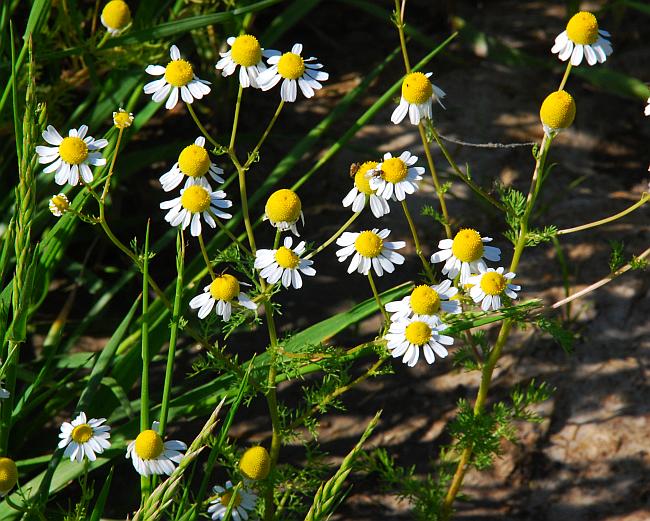Matricaria chamomilla L.
Wild Chamomile

Introduced
CC = *
CW = 5
MOC = 18
© SRTurner
Matricaria chamomilla L.Wild Chamomile | |
 |
Introduced CC = * CW = 5 MOC = 18 |
© SRTurner |
|
Family - Asteraceae/Anthemideae Habit - Taprooted annual.
Stems - Ascending to erect, branched, to 60 cm, ridged, usually glabrous. Distinctive, sweet odor from crushed foliage.
Leaves - Alternate, short-petiolate or sessile, with somewhat clasping bases. Blades to 7 cm, oblong in outline, deeply 1-3 times pinnately lobed, the ultimate lobes to 15 mm, linear to threadlike, glabrous.
Inflorescences - Solitary heads or loose clusters at branch tips.
Heads - Receptacles strongly convex, conical, tending to elongate with advancing maturity, hollow, naked. Heads radiate, the stalks 2-6 cm long. Involucre 2-3 mm long.
Flowers - Ray florets 10-15, perfect, the ligule often becoming deflexed with age, the corolla 4-10 mm long, white. Disc florets numerous, perfect, with the corolla 1.5-2.0 mm long, mostly 5-lobed, yellow. Pappus a short collar or crown (0.2-0.6 mm long).
Flowering - April - October. Habitat - Fields, roadsides, open disturbed areas. Origin - Native to Eurasia, Africa. Lookalikes - Tripleurospermum inodorum, Anthemis spp.; more broadly, Leucanthemum vulgare, Erigeron pulchellus. Other info. - This is a common species in flood plain areas of the Missouri River, where it can form large stands. The heads appear similar to daisies, but the leaves are much different and the foliage much more aromatic. The aroma also distinguishes this plant from the closely related Tripleurospermum inodorum, which also occurs in Missouri but is scentless and far less common. Photographs taken near Augusta, St. Charles County, MO, 5-9-2009, 5-4-2011 and 4-10-2012, and at Shaw Nature Reserve, Franklin County, MO, 6-13-2021 (SRTurner). |